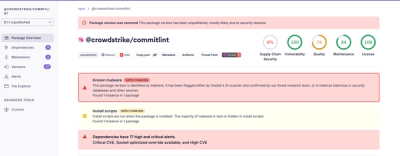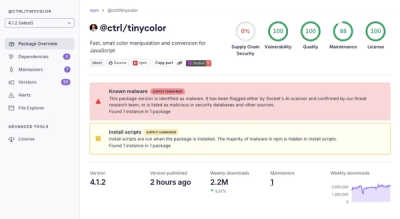<tab-container> element
A accessible tab container element with keyboard support. Follows the ARIA best practices guide on tabs.
Installation
$ npm install @github/tab-container-element
Usage
import '@github/tab-container-element'
<tab-container>
<button type="button" id="tab-one" role="tab" aria-selected="true">Tab one</button>
<button type="button" id="tab-two" role="tab" tabindex="-1">Tab two</button>
<button type="button" id="tab-three" role="tab" tabindex="-1">Tab three</button>
<div role="tabpanel" aria-labelledby="tab-one">
Panel 1
</div>
<div role="tabpanel" aria-labelledby="tab-two" hidden>
Panel 2
</div>
<div role="tabpanel" aria-labelledby="tab-three" hidden>
Panel 3
</div>
</tab-container>
If none of the tabs have aria-selected=true, then the first tab will be selected automatically. You can also add the default-tab=N attribute to avoid having to set aria-selected=true on the desired tab, where N is the 0-based tab index:
<tab-container default-tab="1">
<button type="button" id="tab-one" role="tab">Tab one</button>
<button type="button" id="tab-two" role="tab">Tab two</button>
<button type="button" id="tab-three" role="tab">Tab three</button>
</tab-container>
### Events
- `tab-container-change` (bubbles, cancelable): fired on `<tab-container>` before a new tab is selected and visibility is updated. `event.tab` is the tab that will be focused and `tab.panel` is the panel that will be shown if the event isn't cancelled.
- `tab-container-changed` (bubbles): fired on `<tab-container>` after a new tab is selected and visibility is updated. `event.tab` is the tab that is now active (and will be focused right after this event) and `event.panel` is the newly visible tab panel.
### Parts
- `::part(tablist-wrapper)` is the wrapper which contains `before-tabs`, `tablist` and `after-tabs`.
- `::part(tablist)` is the container which wraps all tabs. This element appears in ATs as it is `role=tablist`.
- `::part(panel)` is the container housing the currently active tabpanel.
- `::part(before-tabs)` is the container housing any elements that appear before the first `role=tab`. This also can be directly slotted with `slot=before-tabs`. This container lives outside the element with role=tablist to adhere to ARIA guidelines.
- `::part(after-tabs)` is the container housing any elements that appear after the last `role=tab`. This also can be directly slotted with `slot=after-tabs`. This container lives outside the element with role=tablist to adhere to ARIA guidelines.
- `::part(after-panels)` is the container housing any elements that appear after the last `role=tabpanel`. This can be useful if you want to add a visual treatment to the container but have content always appear visually below the active panel.
### When tab panel contents are controls
When activated, the whole tab panel will receive focus. This may be undesirable, in the case where the tab panel is itself composed of interactive elements, such as an action list or radio buttons.
In those cases, apply `data-tab-container-no-tabstop` to the `tabpanel` element.
```html
<tab-container>
<button type="button" id="tab-one" role="tab" aria-selected="true">Tab one</button>
<button type="button" id="tab-two" role="tab" tabindex="-1">Tab two</button>
<div role="tabpanel" aria-labelledby="tab-one" data-tab-container-no-tabstop>
<ul role="menu" aria-label="Branches">
<li tabindex="0">branch-one</li>
<li tabindex="0">branch-two</li>
</ul>
</div>
<div role="tabpanel" aria-labelledby="tab-two" data-tab-container-no-tabstop hidden>
<ul role="menu" aria-label="Commits">
<li tabindex="0">Commit One</li>
<li tabindex="0">Commit Two</li>
</ul>
</div>
</tab-container>
Vertical tabs
If <tab-container> is given the vertical attribute it will apply the aria-orientation=vertical attribute to the tablist. This will present to ATs as a vertical tablist, and you can use the attribute to style the tabs accordingly.
In those cases, apply data-tab-container-no-tabstop to the tabpanel element.
<tab-container vertical>
<button type="button" id="tab-one" role="tab" aria-selected="true">Tab one</button>
<button type="button" id="tab-two" role="tab" tabindex="-1">Tab two</button>
<div role="tabpanel" aria-labelledby="tab-one" data-tab-container-no-tabstop>
<ul role="menu" aria-label="Branches">
<li tabindex="0">branch-one</li>
<li tabindex="0">branch-two</li>
</ul>
</div>
<div role="tabpanel" aria-labelledby="tab-two" data-tab-container-no-tabstop hidden>
<ul role="menu" aria-label="Commits">
<li tabindex="0">Commit One</li>
<li tabindex="0">Commit Two</li>
</ul>
</div>
</tab-container>
Browser support
Browsers without native custom element support require a polyfill.
- Chrome
- Firefox
- Safari
- Microsoft Edge
Development
npm install
npm test
License
Distributed under the MIT license. See LICENSE for details.



